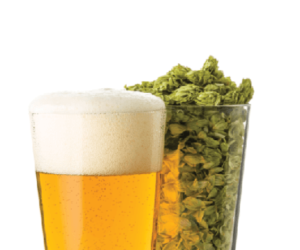Calculating IBUs
In alcoholic beverages, maltiness is usually balanced by another flavor. In wine (and some styles
of beer), maltiness is balanced by acidity. In most styles of beer, maltiness is balanced by the bitterness of the hops. The level of bitterness in beer can be expressed as International Bitterness Units (IBUs). IBUs can be calculated using the following formula:
IBU = [W(oz)*AA%*U*7489]/V(gal)
W is the weight, in ounces, of the hops. AA% is the percentage of alpha acids in the hops, expressed as a number between zero and one. Multiplying weight times alpha acid percent gives you the total amount of alpha acids added to your beer. Often, this number is called AAU.
U is the utilization factor, the percent of the alpha acids that end up contributing towards the bitterness of the beer. U is also expressed as a number between zero and one.
The value for U is affected by many things, including wort gravity and the form of hops used (pellet, plug or whole). But the primary variable is boil time.
When wort is boiled, alpha acids are converted to isomerized alpha acids, the substances that contribute to bitterness. Multiplying the utilization factor times AAU (total alpha acid units added) yields the amount of isomerized alpha acids in the beer. The number 7489 is a conversion factor; if you enter the weight of the hops in grams and the volume of the beer in liters, this term drops out of the equation. Dividing by volume gives you bitterness in IBUs.
Example of Calculating IBUs
Let’s say you brew your pale ale again. You add 2.0 ounces of Northern Brewer hops with 8.5% alpha acid and boil them for 1 hour. With 15 minutes to go in the boil, you add 1.5 oz. of Fuggles hops with 4.0% alpha acid. After choosing values of U from Table 2, we get:
IBU = [2*0.085*0.25*7489]/5+ [1.5*0.04*0.075*7489]/5 = 70.4
Another factor that influences the equation is the aging of the hops. The alpha-acid percentage of the hops may have decreased since the measurement was made. The amount of decrease would depend on how the hops were stored after the initial alpha-acid measurement.
Unfortunately, the homebrewer usually has no way of determining the storage history of his hops. Even if the homebrew shop has stored the hops properly you don’t know how they were treated by the wholesaler or the conditions of transport. To take aging into account, you need to multiply alpha-acid percent by a factor that measured what percentage of the alpha-acids were lost.
The IBU calculation is not as valuable to homebrewers as the calculation of gravity. There is no simple way to measure IBU for homebrewers. Since IBUs can’t be directly measured, the utilization factor can’t be accurately estimated for a brewer’s own equipment. As a consequence, most homebrewers use a value of U from a table or graph. The value chosen may not match their brewing practices. In addition, the electronic scales most homebrewers use only measure to the nearest 0.25 oz. so the homebrewer can’t add precise amounts of hops for small-scale variations in IBU.
Despite all this, using the IBU calculation can get the brewer to the right ballpark. Fine-tuning the bitterness calculation further can be done by trial and error.


